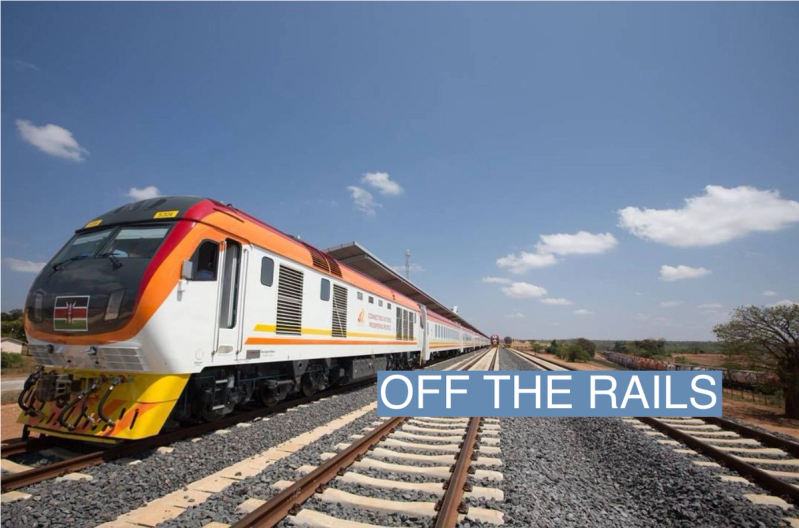The News

Kenya’s transport secretary took to Twitter earlier this week to post documents, including three agreements of the $5 billion loans advanced to Kenya by China’s Export-Import Bank (Exim Bank) for the construction of the 590-kilometer Mombasa-Nairobi-Naivasha Standard Gauge Railway (SGR).
Kipchumba Murkomen’s decision to release the agreements signed by the Export-Import Bank of China and the Kenyan government nearly a decade ago follows a campaign promise made by President William Ruto several months ago. The SGR is the largest infrastructure project since Kenya’s independence and has been dogged by allegations of corruption, wastage and a lack of transparency on the terms of the deal with the Chinese. But the latest revelations, which didn’t include the commercial contract, sparked political and legal reactions from the public and politicians.
Until Sunday, the terms of the loan secured between May 2014 and December 2015 amounting to about $5.08 billion had never been revealed to the public or the parliamentary oversight committees. The secrecy raised speculation on exactly how much Kenya had borrowed from China and which assets the government had listed as collateral or security.
While in office, President Uhuru Kenyatta had promised to make the terms of the Chinese contracts public but left office in September without ever doing so.
Ruto, who served Kenyatta as his deputy, turned the SGR contract issue into an effective campaign tool, stating that it was in the people’s interest to understand its contents.
Muchira’s view
The Mombasa-Nairobi railway was meant to play a vital role in connecting Kenya’s biggest port to its biggest city — in theory encouraging commercial traffic to move from its overburdened road network. It’s become a lightning rod for economic and political controversy, with the previous government alleged to have overpaid for a railway that has not proven to be as economically viable as promised.
Both Murkomen and President Ruto, who took office in September, served in the previous regime as deputy president and Senate’s deputy speaker, respectively — meaning they had key roles in the government which secured these loans on behalf of Kenyans.
Murkomen’s weekend revelations seem to be a dramatic attempt to distance Ruto’s administration from the political baggage of the Kenyatta regime. Ruto, who was an active member of that administration before falling out with his boss, needs to find ways to show Kenyans he’s fulfilling his campaign promises.
But the selective release of documents has sparked backlash from Kenyans demanding to see full details of the actual commercial contract. The agreements released so far show that, unsurprisingly, China Exim Bank had an upper hand in negotiations and minimized its risk by dictating terms — including the crucial requirement that any disputes be negotiated in Beijing. That fuels concerns that Kenyan assets are at risk from a Chinese takeover in the event of a debt payment default.
President Ruto’s response has been to attempt to distance himself from the deal by blaming it on the previous regime. There’s also the view among some that Ruto is trying to endear his administration to the West and away from China.
Room for Disagreement
There has been some discussion in Kenyan media and legal circles about the risk to China-Kenya relations when a cabinet member reveals the terms of a contract with a Chinese state-owned enterprise. China is Kenya’s largest bilateral lender.
“Part of the reason why the agreement was kept confidential was to avoid politicization,” said Dan Okatch, a lawyer at Okatch & Partners Law firm based in Nairobi. “China is a country with a reputation to guard, and would not want to be embroiled in local politics,” he said. He added, “What CS Murkomen has done is certainly a breach of agreement and has exposed Kenya to a risk of an extensive and costly suit, which could lead to severed ties between the two countries.”
The View From Abuja, Nigeria
The tensions around how much a government can or should borrow from China to fund infrastructure projects is a pan-African debate. Nigeria’s government has pursued a programme of railway construction under President Muhammadu Buhari’s administration. Much of the work has been funded by loans from China but there’s no guarantee the availability of funds will continue. Earlier this year transport minister Rotimi Amaechi said the flow of money from Beijing has stopped.
“We are stuck with lots of our projects because we cannot get money. The Chinese are no longer funding,” he told Nigeria’s Guardian paper, adding that the Nigerian government was now “pursuing money in Europe.”
Notable
- Chinese diplomats, financiers and leaders of state-owned enterprises have long pushed back at a common narrative from the West that the world’s second largest economy is engaged in something called “debt-trap diplomacy” in Africa. Back in July, China Global South Project reported on an extreme example of that pushback when in the space of a few days in Kenya nearly all major newspapers there ran the same column written by China’s envoy to Nairobi, Zhou Pingjian. That column argued that China was not engaged in predatory lending, referring to it as “pure disinformation.”

